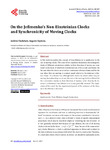
Please use this identifier to cite or link to this item:
http://ricaxcan.uaz.edu.mx/jspui/handle/20.500.11845/535Full metadata record
| DC Field | Value | Language |
|---|---|---|
| dc.contributor.other | https://orcid.org/0000-0001-5324-1834 | es_ES |
| dc.contributor.other | https://orcid.org/0000-0002-1478-7946 | es_ES |
| dc.coverage.spatial | Global | es_ES |
| dc.creator | Chubykalo, Andrew | - |
| dc.creator | Espinoza, Augusto | - |
| dc.date.accessioned | 2018-06-12T16:29:06Z | - |
| dc.date.available | 2018-06-12T16:29:06Z | - |
| dc.date.issued | 2017-03-09 | - |
| dc.identifier | info:eu-repo/semantics/publishedVersion | es_ES |
| dc.identifier.issn | 2153-120X | es_ES |
| dc.identifier.issn | 2153-1196 | es_ES |
| dc.identifier.uri | http://hdl.handle.net/20.500.11845/535 | - |
| dc.identifier.uri | https://doi.org/10.48779/aza1-f963 | - |
| dc.description.abstract | In this work we analyze the concept of time dilation in its application to the rate of moving clocks. The rates of two equiform elementary electromagnetic clocks of different orientations relative to their direction of motion are computed on the basis of relativistic transformations of force and coordinates for the case when the clocks are at rest in a stationary reference frame and for the case when they are moving at constant speed relative to the stationary reference frame. It is shown that, although both clocks run slower when they are moving than when they are at rest, the rate of the moving clocks is affected by their orientation relative to their direction of motion, rather than by the kinematic (relativistic) time dilation as it is now generally assumed. The implication of this result for the experimental proofs of the existence of the kinematic the dilation is discussed. | es_ES |
| dc.language.iso | eng | es_ES |
| dc.publisher | Scientific Research Publishing | es_ES |
| dc.relation | https://www.scirp.org/Journal/PaperInformation.aspx?PaperID=74606 | es_ES |
| dc.relation.uri | generalPublic | es_ES |
| dc.rights | Atribución-NoComercial-CompartirIgual 3.0 Estados Unidos de América | * |
| dc.rights.uri | http://creativecommons.org/licenses/by-nc-sa/3.0/us/ | * |
| dc.source | Journal of Modern Physics, Vol. 8, Núm. 4, Marzo 2017. | es_ES |
| dc.subject.classification | CIENCIAS FISICO MATEMATICAS Y CIENCIAS DE LA TIERRA [1] | es_ES |
| dc.subject.other | Synchronicity | es_ES |
| dc.subject.other | Time Dilation | es_ES |
| dc.subject.other | Length Contraction | es_ES |
| dc.title | On the Jefimenko’s Non-Einsteinian Clocks and Synchronicity of Moving Clocks | es_ES |
| dc.type | info:eu-repo/semantics/article | es_ES |
| Appears in Collections: | *Documentos Académicos*-- UA Física | |
Files in This Item:
| File | Description | Size | Format | |
|---|---|---|---|---|
| 2017 Journal of Modern Physics, 8, 439-447.pdf | 438,61 kB | Adobe PDF |  View/Open |
This item is licensed under a Creative Commons License
